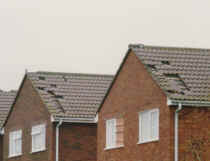| During the recent periods of bad weather across the UK, high winds have
caused damage to roofs. This has left some home owners feeling the need to
form local pressure groups to persuade their Builders to not only repair
their roofs, but to do so in such a manner as to ensure that roof damage
does not happen again to their principle investment. They are citing in
their defence that the roofs were not fixed correctly in the first
instance.
|
 |
| Since the introduction of BS 5534 the code of
practice for slating and tiling in 1978 there has been a calculation
method to determine the minimum-fixing requirement for every roof in the
United Kingdom. |
| Compliance with the tile fixing requirements of BS5534
will automatically ensures compliance with BS8000 The code of practice for
workmanship on building sites: part 6 Slating and Tiling, which in turn
will comply with the requirements of regulation 7 of the Building
Regulations. |
| The National House Builders Council (NHBC)
provides recommendations for every aspect of house construction in its
technical manual. Table 2 of Appendix 7.2-C of the NHBC technical manual
gives minimum fixing recommendations for single-lap interlocking concrete
tiles. Table 3 gives the minimum fixing for plain, double lap tiles with
nibs. |
| Table 2 states that the end tile in each tile
course at a verge, abutment, valley and hip must be nailed or clipped,
also every tile in the first course at eaves and top edges (ridge) must be
nailed or clipped. In many cases this table has been interpreted as the
fixing recommendation for all houses within the NHBC scheme. Many builders
miss the note underneath stating "Additional nails and clips may be
required depending on pitch and degree of exposure. Following the
manufacturer's recommendation. Evidence of calculations in compliance with
Technical Requirement R5 may be required". This is often interpreted
as being optional rather than a mandatory requirement. The statement also
avoids any reference to compliance with BS5534 that is mentioned earlier
in the NHBC technical manual. However by seeking a manufacturers
recommendation, they should be in compliance with BS5534 fixing
recommendations. |
| Table 3 is more definitive with regard to the
fixing of tiles in the general area, a term not clearly explained. It
states that up to 60 degree (rafter pitch) the tiles are to be fixed with
2 nails per tile every fifth course. Over 60 degrees the tiles are to be
fixed with 2 nails per tile in every course. There is no additional note
as with table two relating to further fixing, obtaining a manufacturers
recommendation, or any reference to compliance BS 5534. Whilst the over 60
degree statement does agree with BS5534, below 60 degrees it only complies
in low wind uplift situations. |
| Whilst the NHBC technical manual seeks to
simplify the requirements of roof tile fixings, it would appear that for
some roofs have passed the NHBC final inspection with roof tiles that are
not adequately fixed to comply with Regulation 7 of the building
Regulations. |
| During the recent period of bad weather that
affected most of the UK, the estates of houses built by NHBC registered
Builders, that have incurred damage to roofs have not experienced winds
that have exceeded the wind speeds that could be expected to occur at
least once in any 50 year period for that locality. The 50-year period is
a standard period that is used in the fixing calculation method in BS5534.
On an initial review of the problems, it would appear that all the
affected roofs were not fixed using the manufacturer's recommendations and
calculations may not have been done prior to the roof being tiled. |
| If this is the case, the long-term implications
could mean that many more house owners have a strong claim against their
NHBC backed guarantee. Having had the roof tile fixing issue brought to
their attention, the NHBC may respond by increasing, or clarifying the
tile fixing specification and inspection for all future roofs. The likely
consequence of this discovery may be an increase in the cost of roof
construction by an average of £300 per house. This would cover the extra
roof fixings and any increase in the NHBC guarantee premium to pay for the
claims that may result from tile fixing problem dating back over the last
ten years. |
| The NHBC, and/or the house builders, may try to
deflect blame for the problem back to the tile manufacturers. However,
there is sufficient documentary evidence to show that during the hurricane
force winds that occurred in 1987 across the South East (a once in 200
year event), in exposed locations in Cornwall, South Wales and the western
isles of Scotland, tiled roofs fixed in accordance with BS 5534 have not
sustained damage. However incorrectly fixed roofs have sustained damage. |
| The major roof tile manufacturers all provide a
means of obtaining safe fixing specifications for their products. In most
cases this service is free and the calculation is undertaken from the
answers to approximately 20 questions related to the site and the
building. There is no reason why any tiled roof should not be fixed
correctly given the knowledge contained within the British Standards, the
fixing specification calculation services provided by manufacturers and
the notes contained in the NHBC technical manual. |
| The adoption of the recommendations contained
within BS5534 and BS 8000 part 6, as promoted by the Government and
Insurance industry initiative, the Roofing Hallmark Scheme, could reduce
the long-term claims on the insurance industry, including the NHBC.
Especially as scientists are informing us that periods of high winds will
occur more frequently with the changes that are predicted in the global
climate. |